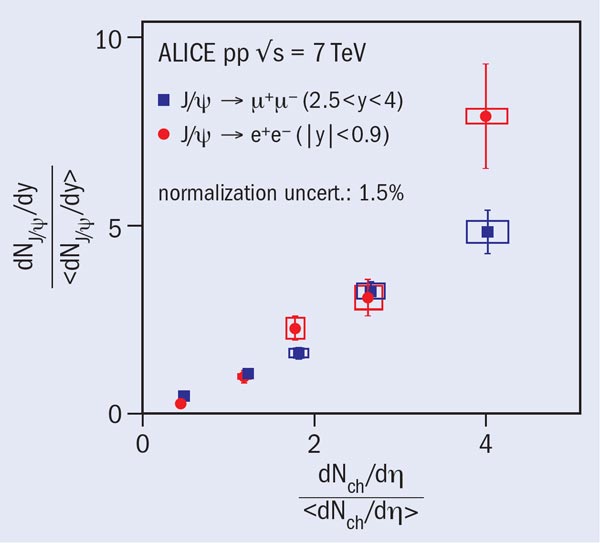The J/Ψ meson, a bound state of a charm and an anticharm quark, has always been an important testing ground for quantum chromodynamics (QCD). However, understanding J/Ψ production in proton–proton (pp) collisions remains a challenge. While the production of unbound c–c pairs via partonic (quark and gluon) hard-scattering processes can be described within perturbative QCD, the subsequent formation of a colourless bound state, such as the J/Ψ, leaves much room for theoretical modelling. Recently, a new measurement by the ALICE collaboration at the LHC adds yet another challenge for theoretical models.
ALICE, which among the LHC experiments has the unique capability to identify J/Ψ at low transverse momenta, measured J/Ψ production in pp collisions at √s = 7 TeV as a function of the charged-particle multiplicity (dNch/dη) of the underlying event. As the figure shows, this study revealed a remarkably linear increase of the J/Ψ yield with dNch/dη (Abelev et al. 2012). Even though the charged-particle multiplicity is measured only at central rapidity, this increase is seen in not only this region but also at forward rapidities.

The charged-particle multiplicity is mostly the result of processes happening with a small momentum transfer, i.e. so-called soft processes. J/Ψ mesons, on the other hand, are expected to be produced in hard processes, as described above. The assumption has been that the two are not necessarily correlated. However, the measurement by ALICE shows that the yields of the heavy J/Ψ scale just like those of any other light hadron. Regardless of its high rest mass (3.097 GeV/c2) the J/Ψ behaves just like a “light” particle.
The event multiplicity dNch/dη could be directly related to the impact parameter of a given pp collision. This would be analogous to heavy-ion physics where, depending on the centrality of the reaction, different numbers of binary collisions occur between the nucleons. A similar situation could arise in pp collisions at LHC energies because the probability is high that many collisions take place between the quarks and gluons inside the protons. Most of these multiparton interactions are usually assumed to have a relatively low momentum-transfer and therefore to affect mainly soft-particle production. That J/Ψ production behaves similarly to the production of other charged particles might indicate that harder processes are also affected by multiparton interactions.
This measurement is an example of the new experimental opportunities that the LHC has opened up, allowing the correlation of observables on soft and hard scales. Further studies on the charged-particle multiplicity dependence of other hard processes, such as the production of Υ, open charm and beauty, should shed more light on the nature of this effect.
Further reading
B Abelev et al. (ALICE collaboration) 2012 arXiv:1202.2816 submitted to Phys. Lett. B.





